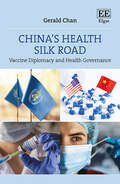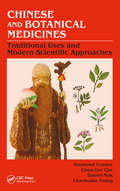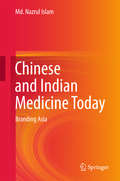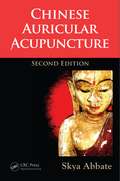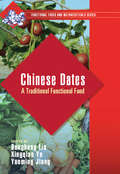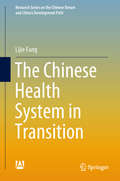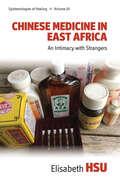- Table View
- List View
China’s Health Silk Road: Vaccine Diplomacy and Health Governance
by Gerald ChanIn the fourth instalment of his ‘Belt and Road Initiative’ series, Gerald Chan provides a critical analysis of China’s vaccine diplomacy. Locating it within China’s wider infrastructure development strategy, Chan deploys geo-developmentalism as a theoretical tool to analyse its contribution to a new global health order, particularly with the pandemic pushing the country to the forefront of vaccine exportation.This timely book considers the contention between patient rights and patent rights, and the position of China in this debate as a relative latecomer to the global health game. Chan covers the infrastructural and digital innovations involved in recent health initiatives; moving on to unravel Sino-US rivalry and what this means for global health development; and assess the export of healthcare to Africa. Ultimately, this innovative study argues that China’s tilt towards providing life saving drugs over the rights of patent holders will lead to better healthcare for the global poor.Providing a fresh perspective on China’s unfolding diplomatic strategies, China’s Health Silk Road will appeal to students and scholars of international relations, global development, Asian politics and health policy. Furthermore, it will prove crucial reading for policy-makers and think tank analysts looking to better understand Sino-American relations and global health.
China's Last Nomads: History and Culture of China's Kazaks
by Linda Benson Ingvar SvanbergThis study, based on Chinese publications and archival materials as well as on recent fieldwork, provides an up-to-date treatment of Kazak history and culture, emphasizing the Kazaks in 20th-century China and, in particular, their status today as one of China's minority nationalities.
China's Last Nomads: History and Culture of China's Kazaks
by Linda Benson Ingvar SvanbergThis study, based on Chinese publications and archival materials as well as on recent fieldwork, provides an up-to-date treatment of Kazak history and culture, emphasizing the Kazaks in 20th-century China and, in particular, their status today as one of China's minority nationalities.
Chinese and Botanical Medicines: Traditional Uses and Modern Scientific Approaches
by Raymond Cooper Chun-Tao Che Daniel Kam-Wah Mok Charmaine Wing-Yee TsangChinese and Botanical Medicines: Traditional Uses and Modern Scientific Approaches is a classroom-tested book that contains a balance of chemistry, the history of Traditional Chinese Medicine (TCM), and the theory and practice of a modern TCM practitioner. This distinct book reviews the scientific methods for collecting data and supporting evidence for the efficacy and safety of Chinese drugs and medicines. It also reflects on the different views on health, disease and therapy, and their impacts on the relationships between man and nature.
Chinese and Botanical Medicines: Traditional Uses and Modern Scientific Approaches
by Raymond Cooper Chun-Tao Che Daniel Kam-Wah Mok Charmaine Wing-Yee TsangChinese and Botanical Medicines: Traditional Uses and Modern Scientific Approaches is a classroom-tested book that contains a balance of chemistry, the history of Traditional Chinese Medicine (TCM), and the theory and practice of a modern TCM practitioner. This distinct book reviews the scientific methods for collecting data and supporting evidence for the efficacy and safety of Chinese drugs and medicines. It also reflects on the different views on health, disease and therapy, and their impacts on the relationships between man and nature.
Chinese and Indian Medicine Today: Branding Asia
by Md. Nazrul IslamThis book discusses Asian medicine, which puts enormous emphasis on prevention and preservation of health, and examines how, in recent decades, medical schools in Asia have been increasingly shifting toward a curative approach. It offers an ethnographic investigation of the scenarios in China and India and finds that modern students and graduates in these countries perceive Asian medicine to be as important as Western medicine. There is a growing tendency to integrate Asian medicine with Western medical thought in the academic curriculum that has led to a gradual decline of Asian medical thought and practices. At the same time, there has been a massive rise in patent drugs, health products and cosmetics being sold under the brand names of Asian medicine or herbal medicine. Most of these drugs and health products do not follow the classical formulas found in the Asian medical texts. The book analyses these texts and concludes that contemporary Asian medicine rarely follows the classical texts, and in fact uses Asian medicine brands to sell Western health products and practices.With a particular focus on the formal and professional sector of Chinese herbal medicine and Indian ayurvedic medicine in urban areas, this book appeals to a broad readership, including undergraduate students and academics as well as non-experts.Md. Nazrul Islam is an Associate Professor in the General Education Office, United International College, Beijing Normal University-Hong Kong Baptist University. He was a Visiting Associate Professor in the School of Population and Public Health, University of British Columbia (2015-16) during which time he completed this book manuscript.
Chinese Auricular Acupuncture
by Skya AbbateChinese Auricular Acupuncture provides students and practitioners with a clear, concise, and user-friendly manual on ear acupuncture. It reduces the need for memorization by presenting a method of ear acupuncture that is in keeping with the underpinnings of traditional Chinese medicine. The book can be independently studied and easily used to treat
Chinese Burn Surgery
by Zongcheng YangThis is a comprehensive book in burn surgery, written by 25 experts in China. It summarizes the theoretical basis of and clinical experience in the prevention and control of burn injuries. It is a comprehensive and up-to-date reference book for surgeons and scientists working with burn management. The different degree of burns and surgical techniques during burn wound care, reconstruction and healing are reviewed separately. Authors also introduce successful cases in different kinds of burns.
Chinese Dates: A Traditional Functional Food (Functional Foods And Nutraceuticals Ser.)
by Dongheng Liu; Xingqian Ye; Yueming JiangChinese Dates: A Traditional Functional Food delivers unique information on Chinese dates (jujubes) as typical ethical foods and traditional health-promoting foods. It conveys a better understanding of Asian food cultures and provides historical information in regard to traditional functional foods and their dietary applications. It discusses the h
Chinese Dates: A Traditional Functional Food (Functional Foods And Nutraceuticals Ser.)
by Dongheng Liu Xingqian Ye Yueming JiangChinese Dates: A Traditional Functional Food delivers unique information on Chinese dates (jujubes) as typical ethical foods and traditional health-promoting foods. It conveys a better understanding of Asian food cultures and provides historical information in regard to traditional functional foods and their dietary applications. It discusses the h
Chinese Drugs of Plant Origin: Chemistry, Pharmacology, and Use in Traditional and Modern Medicine
by Weici Tang Gerhard EisenbrandTraditional Chinese medicine has been used for thousands of years by a large population. It is currently still serving many of the health needs of the Chinese people; and still enjoying their confi dence it is practised in China in parallel with modern Western medical treatment. In addition to scientific organisations dedi cated to modern Western medicine, e. g. the Chinese Academy of Medical Sciences and various medical schools, a series of parallel institutions have been established in China to promote traditional Chinese medicine, such as the Academy of Traditional Chinese Medicine and training institutions. Almost all hospitals in China have a department of traditional medicine. Furthermore, a large number of scientific journals are dedicated to traditional Chinese medicine, covering both experimental and clinical investigations. Medicinal materials constitute a key topic in the treatment of disease according to traditional Chinese medicine. The Chinese Pharmacopoeia (1985 edition) is therefore divided into two sepa rate volumes, Volume I containing traditional Chinese medicinal materials and preparations and Volume II containing pharmaceu tics of Western medicine. The oldest Chinese review of medicinal materials, Shennong Bencao Jing (100-200 A. D. ), covered 365 herbal drugs. The clas sic compilation in this field, Bencao Gangmu (Compendium of Materia Medica), was published in 1578 by Li Shi-zhen and recorded as many as 1898 crude drugs of plant, animal and min eral origin.
The Chinese Health System in Transition (Research Series on the Chinese Dream and China’s Development Path)
by Lijie FangThis book provides an overview of the ongoing transition in China’s health system, especially focusing on the new healthcare reform initiated in 2009. First, it reviews the changes in China’s healthcare system from the 1950s to 2008, establishing the situation when the reform was introduced. The book subsequently analyzes the social and economic context in which the health system is embedded. Since the primary focus is on the new healthcare reform, the book introduces the blueprint and the year-for-year development of the new healthcare reform, as well as the specific reforms in health financing, public hospitals, and primary care. Given its central importance in the health system, the book also described major trends in long-term care in the past several years. In addition, it examines the health policy-making process with a case study of the New Cooperative Medical Scheme of China. Lastly, the book assesses the performance of China’s health system and predicts future developmental trends.
Chinese Herbal Formulas: Chinese Herbal Formulas: Treatment Principles and Composition Strategies E-Book
by Yifan YangTraditionally the study of Chinese herbal formulas has involved memorizing hundreds of classic formulas, and recognizing and summarizing the relevant treatment rules and formula-making strategies in order to create appropriate formulas for treatment. This new book by Yifan Yang, author of Chinese Herbal Medicines: Comparisons and Characteristics (which pioneered the comparative method of single herb study), introduces a new approach to formula study. The reader is shown how to use the basic treatment rules and composition strategies, abstrated from hundreds of formulas, in order to create individual formulas for treating a variety of syndromes. The method is clear and easy to understand, with a systematic approach and an emphasis on essential knowledge. Key features - 19 common syndromes and 60 sub-syndromes are described and discussed in detail, illustrated with clear line drawings - Chinese diagnosis of syndromes are realated to the Western disease names - Treatment principles and plans are given for each syndrome - Principles of herb selection are introduced with recommendations and explanations of specific herbs in relation to each syndrome - 166 classic formulas are given as examples - Treatment strategies in complicated syndromes, treatment sequences, cautionary advice for herbs and combinations with Western drugs, dosage management in a variety of conditions and commonly used pairs of herbs are all discussed - Detailed indexes and contents lists facilitate quick reference and searching within the text. Chinese Herbal Formulas: Treatment Principles and Composition Strategies is written by an experienced practitioner and lecturer of Chinese herbal medicine. It is the ideal companion to Chinese Herbal Medicines: Comparisons and Characteristics, by the same author. - Ofers a method of learning formula composition clearly and concisely- Detailed syndrome differentiation and analysis help students to understand the syndromes and give clear orientation in their treatment plan- Includes clear and detailed information on selection of herbs- Abstracts from each chapter allow practitioners to quickly select herbs in the clinical practice- Also covers dosage management, special strategies for treated complicated cases, contraindications of using formulas and treatment orders
Chinese Herbal Medicines: Comparisons And Characteristics
by Yifan YangStudents and practitioners of Chinese herbal medicine must learn hundreds of commonly used herbs as the first step in studying Chinese herbal medicine. Additionally, junior practitioners lack the clinical experience required to ensure that they can skilfully select the appropriate herbs to use in the formulas. This presents them with a major challenge. Chinese Herbal Medicines: Comparisons and Characteristics presents a method of learning individual herbs through vivid and clear discussion of their characteristics and through a comparison with other herbs of their characteristics and strengths. This clear and logical approach makes it easy for the user to understand and memorize the functions of specific herbs. It also enables experienced practitioners to improve their therapeutic results through the use of better formulas. Key features of the new edition - Retains the same easy to follow format as the first edition - Presents detailed comparisons and discussions of commonly used Chinese herbs - Provides a series of thought-provoking questions with very detailed answers - Structured to help the reader to learn and memorize the content more easily - The easy-to-use question-andanswer format is convenient to apply in the consulting room - Includes discussion of clinical applications to help with the practical use of the information in clinical setting - Revised and updated with particular emphasis on the safe use of Chinese herbal medicines - New appendices provide information on safe dosages, commonly used herbal combinations and the meanings of Chinese words used in herbal names - Provides a sound foundation for the study and practice of Chinese herbal medicine. Chinese Herbal Medicinse: Comparisons and Characteristics is already wellknown to students and practitioners of Chinese herbal medicine. This new, improved edition will continue to be of value to students and practitioners alike. It is now supported by a new companion volume by the same author entitled Chinese Herbal Formulas: Treatment Principles and Composition Strategies. Together these two books provide a sound foundation for the study and practice of Chinese herbal medicine. - Detailed and vivid comparisons and discussions of Chinese herbs to help the reader memorize and understand their characteristics - Structured as a series of thought-provoking questions with very detailed answers, again to help memorize the content - Includes "clinical applications" subsection within each section, to help the reader understand how to apply information better and more accurately in the clinical setting.
Chinese Massage Manual: A comprehensive, step-by-step introduction to the healing art of Tui na
by Sarah PritchardThis comprehensive, introductory book covers the essentials of Chinese massage (Tui na), including the fundamental principles of Chinese medicine, and the 20 basic massage techniques. It also includes treatment advice for 12 common ailments, so that the reader can practice what he or she has learnt to good effect. The book covers:· Instruction on 20 specialized massage techniques· How to locate over 50 points to treat specific problems· How to combine massage with Qi Gong for maximum energy and wellbeing· Step-by-step treatments for common colds, lower back pain, sciatica and more· Clear photographs, diagrams and chartsThe author provides key information in clear, easy to refer to tables and diagrams, making this also an excellent reference for students, and practitioners of related disciplines.
Chinese Medical Gynaecology: A Self-Help Guide to Women's Health
by Eddie DowdMany of the issues that relate to women's health from period pain to infertility, can be self-treated with Chinese medicine approaches, and this clear and practical guide explains how to assess symptoms and choose the most effective form of treatment. Written for women interested in taking a more active role in their own health and well-being, the book covers health issues of the menstrual cycle, pregnancy and post-partum, menopause, fertility, and fibrocystic breast disease amongst others. Taking a holistic approach that includes the traditional Chinese approach that food is medicine, appropriate recipes are included along with other treatment suggestions. The author provides an overview of the history of Chinese medicine and a clear and simple explanation of the principles of its theoretical basis, including the 5 vital substances, organ theory, channel (meridian theory) and the nature of Yin and Yang, thus providing a context for understanding symptoms from a Chinese perspective, and treatments that can be undertaken at home.
Chinese Medical Gynaecology: A Self-Help Guide to Women's Health (PDF)
by Eddie DowdMany of the issues that relate to women's health from period pain to infertility, can be self-treated with Chinese medicine approaches, and this clear and practical guide explains how to assess symptoms and choose the most effective form of treatment. Written for women interested in taking a more active role in their own health and well-being, the book covers health issues of the menstrual cycle, pregnancy and post-partum, menopause, fertility, and fibrocystic breast disease amongst others. Taking a holistic approach that includes the traditional Chinese approach that food is medicine, appropriate recipes are included along with other treatment suggestions. The author provides an overview of the history of Chinese medicine and a clear and simple explanation of the principles of its theoretical basis, including the 5 vital substances, organ theory, channel (meridian theory) and the nature of Yin and Yang, thus providing a context for understanding symptoms from a Chinese perspective, and treatments that can be undertaken at home.
Chinese Medicine: The Web That Has No Weaver (PDF)
by Ted J. KaptchukIn the ancient tradition of Chinese medicine, illness is a disharmony of the whole body. The aim is to restore harmony through herbal medicine, acupuncture, moxibustion and the diagnostic skills of the physician. The governing principle is to balance Yin and Yang and to restore the interconnections between all aspects of the organism. This remarkable book explains the theory and practice of Chinese medicine. More than that, it mixes the most up-to-date knowledge of the oriental approach to healing with cutting-edge scientific research. 'While the book's rich detail makes it of great use to practising healers, it is in its entirety very simply written, enjoyable reading for the layman... An instructive, profound and important work.' Professor Martin Schwartz, University of California, Berkeley.
Chinese Medicine
by Tom WilliamsChinese medicine is growing ever more popular in the West. Increasing numbers of us know that acupuncture and herbal remedies can help us – yet we do not understand how they work or why. Tom Williams’ timely introduction shows how Chinese medicine interprets the human body, and how Qi, Jing and Shen (the three treasures – energy, essence and mind/spirit) and the other basic body substances interact to bring bodily harmony.
Chinese Medicine and the Management of Hypermobile Ehlers-Danlos Syndrome: A Guide for Practitioners
by Paula BrunoHypermobility syndromes are more common, complex and varied than most practitioners realise. Every hypermobile patient is unique, and therefore challenging to treat using a pre-set paradigm or protocol. The hEDS population can be underserved by Western medicine and there is much that Chinese medicine can do for this community. This book is one of the first of its kind - a Chinese Medicine text focusing specifically on hypermobile Ehlers-Danlos Syndrome. Presenting existing bio-medical narratives before providing an in-depth exploration of the Chinese Medicine paradigms, this guide gives an overview of comprehensive treatment scenarios and addresses issues faced by EDS patients including pain management, psycho-emotional challenges, disruption of gut health, and chronic inflammation, including post-Lyme syndrome.
Chinese Medicine and Transnational Transition during the Modern Era: Commodification, Hybridity, and Segregation
by Md. Nazrul IslamThis volume analyses the transition of Chinese medicine during the modern era, and the development of product and service niches in selected countries: China, Malaysia, Japan and the Philippines. By investigating the major actors behind the transition, it explores in what way and to what extent these actors affect the transition. It argues that the transnational transition of Chinese medicine is caused not only by spontaneous cultural and social factors, i.e. population growth, technological innovation and acculturation, but also by hegemonic political and economic factors such as Western influence, adoption of the philosophy of modern state, and global commodification of indigenous medical specialties.
Chinese Medicine for Upper Body Pain
by Benjamin ApichaiPain medication is widely used to treat patients who suffer from acute and chronic pain. However, it is not the only treatment option available for managing traumatic and chronic upper body pain. Chinese medicine is a popular option without the risk of adverse side effects that may come with opioid use. Chinese Medicine for Upper Body Pain further explores other pain management options, introducing treatments such as acupuncture, herbal medicine, and Tui Na (Chinese bodywork). This book provides concise explanations in terms of anatomy, pathology, and etiology for both Western and Chinese medicine, and also provides selfcare instructions that are effective and easy to follow. Key Features: Introduces treatments in Chinese medicine including acupuncture with traditional methods such as acupuncture point selection and its modifications, electroacupuncture, point bleeding, auricular medicine, cupping, and moxibustion; herbal formulas with their sources and modifications, and Tui Na therapy. Recommends dietary, exercise, and self-care protocols for patients. Includes photos for reference and ease of understanding. This book is suitable for self-care practitioners and students of Chinese medicine practices as well as patients who want to better understand and mitigate their pain. Along with Chinese Medicine for Lower Body Pain (ISBN: 9780367235857), the author covers the use of Chinese medicine for pain management for the complete body.
Chinese Medicine for Upper Body Pain
by Benjamin ApichaiPain medication is widely used to treat patients who suffer from acute and chronic pain. However, it is not the only treatment option available for managing traumatic and chronic upper body pain. Chinese medicine is a popular option without the risk of adverse side effects that may come with opioid use. Chinese Medicine for Upper Body Pain further explores other pain management options, introducing treatments such as acupuncture, herbal medicine, and Tui Na (Chinese bodywork). This book provides concise explanations in terms of anatomy, pathology, and etiology for both Western and Chinese medicine, and also provides selfcare instructions that are effective and easy to follow. Key Features: Introduces treatments in Chinese medicine including acupuncture with traditional methods such as acupuncture point selection and its modifications, electroacupuncture, point bleeding, auricular medicine, cupping, and moxibustion; herbal formulas with their sources and modifications, and Tui Na therapy. Recommends dietary, exercise, and self-care protocols for patients. Includes photos for reference and ease of understanding. This book is suitable for self-care practitioners and students of Chinese medicine practices as well as patients who want to better understand and mitigate their pain. Along with Chinese Medicine for Lower Body Pain (ISBN: 9780367235857), the author covers the use of Chinese medicine for pain management for the complete body.
Chinese Medicine in East Africa: An Intimacy with Strangers (Epistemologies of Healing #20)
by Elisabeth HsuBased on fieldwork conducted between 2001-2008 in urban East Africa, this book explores who the patients, practitioners and paraprofessionals doing Chinese medicine were in this early period of renewed China-Africa relations. Rather than taking recourse to the ‘placebo effect’, the author explains through the spatialities and materialities of the medical procedures provided why - apart from purchasing the Chinese antimalarial called Artemisinin - locals would try out their ‘alternatively modern’ formulas for treating a wide range of post-colonial disorders and seek their sexual enhancement medicines.
Chinese Medicine Psychology: A Clinical Guide to Mental and Emotional Wellness
by Dr Mary Garvey Professor Qu LifangBoth an introduction to Chinese medicine psychology and a clinical guide for Chinese medicine, this book facilitates and promotes the management of mind and emotion-related illnesses. Based on recent and ancient Chinese sources, it explores and explains previously unavailable material on the generational and ancestral aspects of human mentality, as well as its context within the natural world and the evolution of human life. The first part of the book includes a detailed introduction to the theory of Chinese medicine psychology as well as the modern developments that surround it, whilst the second part is a guide to clinical practice.Chinese Medicine Psychology allows access to invaluable resources and is an indispensable guide for Chinese medicine practitioners, students and healthcare professionals.
